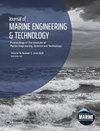Design and evaluation of novel static mixers for SCR application
IF 4.4
4区 工程技术
Q1 ENGINEERING, MARINE
Journal of Marine Engineering and Technology
Pub Date : 2023-11-01
DOI:10.1080/20464177.2023.2275352
引用次数: 0
Abstract
AbstractStatic mixers are widely used in selective catalytic reduction (SCR) systems to improve the conversion efficiency and service life of the catalyst by better mixing ammonia and the exhaust stream. However, the structure of the mixer needs to be designed carefully to minimise the loss of the system pressure caused by its installation. In this work, experiments and simulations are conducted to evaluate the mixing performance of the static mixers and the system pressure loss. The simulations and experimental results have good agreement. Four novel static mixers are designed and compared with a commercial static mixer to demonstrate their performance. The results show that the box mixer can accomplish less pressure loss (690 Pa) and more homogenous mixing (CoV = 5.4%), and it can thus be used to improve the mixing of ammonia and the exhaust stream in SCR systems.KEYWORDS: Static mixerSCRmixingevaluationCFD Disclosure statementNo potential conflict of interest was reported by the author(s).Additional informationFundingThis work was supported by National Key Research and Development Program of China: [Grant Number 2022YFE0124300; 2022YFB3504104].Notes on contributorsYouhong XiaoYouhong Xiao, born in 1978, Ph.D. in Naval Architecture and Marine Engineering from University of Strathclyde in 2009. He has been a Professor in Department of Power and Energy Engineering, Harbin Engineering University since 2018. His research interests include the vibration noise control of power units, noise source identification technology, diesel engine emission purification, and muffling integrated control technology.Hui ZhaoHui Zhao is a Ph.D. candidate in the college of Power and Energy Engineering, Harbin Engineering University. He received the bachelor degree in marine engineering from the School of NAOCE, Shanghai Jiao Tong University, Shanghai, China, in 2015 . His current research interests include exhaust emission control of marine diesel engine.Xinna TianXinna Tian, born in 1987, Ph.D. in Naval Architecture, Ocean and Marine Engineering from University of Strathclyde in 2016. She has been a Senior Engineer in China Shipbuilding Power Engineering Co., Ltd., Shanghai, since 2018. Her research interests include marine diesel NOx reduction, marine ship Carbon dioxide capture.Tao SunTao Sun, born in 1978, Ph.D. in Marine Engineering from Harbin Engineering University in July 2005. His Research Interests including simulation and test of aerodynamic performance of compressor, heat transfer and cooling technology of turbomachinery, performance of the intake and exhaust system of the power unit, aerothermodynamics of turbomachinery and multiphysics coupling simulation of fluid machinery.新型可控硅静态混合器的设计与评价
摘要静态混合器被广泛应用于选择性催化还原(SCR)系统中,通过更好地混合氨和废气流来提高催化剂的转化效率和使用寿命。然而,混合器的结构需要仔细设计,以尽量减少由其安装引起的系统压力损失。本文通过实验和仿真对静态混合器的混合性能和系统压力损失进行了评价。仿真结果与实验结果吻合较好。设计了四种新型静态混合器,并与商用静态混合器进行了比较。结果表明,箱式混合器的压力损失较小(690 Pa),混合更加均匀(CoV = 5.4%),可用于改善SCR系统中氨与排气流的混合。关键词:静态混合器scmixingevaluation cfd披露声明作者未报告潜在利益冲突。本研究受国家重点研发计划资助:[批准号2022YFE0124300;2022 yfb3504104]。肖友红,1978年生,2009年毕业于英国斯特拉斯克莱德大学,获船舶与海洋工程博士学位。他自2018年起担任哈尔滨工程大学动力与能源工程系教授。主要研究方向为动力装置振动噪声控制、噪声源识别技术、柴油机排放净化、消声综合控制技术。赵辉,哈尔滨工程大学动力与能源工程学院博士研究生。2015年毕业于上海交通大学船舶工程学院,获船舶工程学士学位。主要研究方向为船用柴油机废气排放控制。田欣娜,1987年生,2016年毕业于英国斯特拉斯克莱德大学船舶、海洋与海洋工程专业,获博士学位。自2018年以来,她一直担任上海中国船舶动力工程有限公司的高级工程师。主要研究方向为船用柴油氮氧化物还原、船舶二氧化碳捕获等。孙涛,1978年生,2005年7月毕业于哈尔滨工程大学海洋工程专业,获博士学位。主要研究方向为压气机气动性能仿真与测试、涡轮机械传热与冷却技术、动力装置进排气系统性能、涡轮机械气动热力学、流体机械多物理场耦合仿真。
本文章由计算机程序翻译,如有差异,请以英文原文为准。
求助全文
约1分钟内获得全文
求助全文
来源期刊

Journal of Marine Engineering and Technology
ENGINEERING, MARINE-
CiteScore
6.30
自引率
0.00%
发文量
15
期刊介绍:
The Journal of Marine Engineering and Technology will publish papers concerned with scientific and theoretical research applied to all aspects of marine engineering and technology in addition to issues associated with the application of technology in the marine environment. The areas of interest will include:
• Fuel technology and Combustion
• Power and Propulsion Systems
• Noise and vibration
• Offshore and Underwater Technology
• Computing, IT and communication
• Pumping and Pipeline Engineering
• Safety and Environmental Assessment
• Electrical and Electronic Systems and Machines
• Vessel Manoeuvring and Stabilisation
• Tribology and Power Transmission
• Dynamic modelling, System Simulation and Control
• Heat Transfer, Energy Conversion and Use
• Renewable Energy and Sustainability
• Materials and Corrosion
• Heat Engine Development
• Green Shipping
• Hydrography
• Subsea Operations
• Cargo Handling and Containment
• Pollution Reduction
• Navigation
• Vessel Management
• Decommissioning
• Salvage Procedures
• Legislation
• Ship and floating structure design
• Robotics Salvage Procedures
• Structural Integrity Cargo Handling and Containment
• Marine resource and acquisition
• Risk Analysis Robotics
• Maintenance and Inspection Planning Vessel Management
• Marine security
• Risk Analysis
• Legislation
• Underwater Vehicles
• Plant and Equipment
• Structural Integrity
• Installation and Repair
• Plant and Equipment
• Maintenance and Inspection Planning.
 求助内容:
求助内容: 应助结果提醒方式:
应助结果提醒方式:


